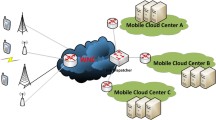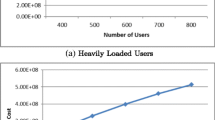Abstract
Mobile cloud computing (MCC) is an emerging technology that is introduced to combat the existing limitations in mobile computing such as constrained energy and storage. MCC enables mobile users to perform their tasks in the operator cloud and benefit from the offered services. On the other hand, operators are required to decrease their costs to stay in the competitive market. In this paper, we propose a method to reduce the cost of power consumption and increase the profit of 4G/5G network operators delivering MCC services. We propose an online method that is based on dynamic processing of mobile users’ demands based on their power consumption in the cloud, called Dyn-PDPC. In this algorithm, the power consumption of demands is estimated based on event counters, and demands are classified and processed accordingly. Unlike the offline methods, the proposed online method can be implemented with the existing information and there is no need for prior knowledge. We also present an extended version of Dyn-SP algorithm, in which we had an unrealistic assumption about the energy consumption of demands. In Dyn-PDPC, by using control parameters, when the electricity price is low, demands with high power consumption are processed, and then the low power-consumption demands are processed. Similarly, when the electricity price is high, demands with low power consumption are processed at first. Simulation results demonstrate that the proposed algorithm has more accuracy, and more reduction in long-term cost compared to other online methods in MCC networks.









Similar content being viewed by others
References
Fehske A, Fettweis G, Malmodin J, Biczok G (2011) The global footprint of mobile communications: the ecological and economic perspective. IEEE Commun Mag 49(8):55–62
Tränk J (2015) 5G—building upon ongoing network disruption. Networks & Connected Products
Pritzker, P., et al., (2013). NIST Cloud Computing Standards Roadmap Working Group, Special Publication 500–291, Version 2. http://nvlpubs.nist.gov/nistpubs/SpecialPublications/NIST.SP.500-291r2.pdf. Accessed 05.05.16
Buzzi S, I CL, Klein TE, Poor HV, Yang C, Zappone A (2016) A survey of energy-efficient techniques for 5G networks and challenges ahead. IEEE J Sel Areas Commun 34(4):697–709
Hameed A et al (2016) A survey and taxonomy on energy efficient resource allocation techniques for cloud computing systems. Comput J 98(7):751–774
Yeganeh H, Vaezpour E (2016) Fronthaul network design for radio access network virtualization from a CAPEX/OPEX perspective. Ann Telecommun 71(11/12):665–676. https://doi.org/10.1007/s12243-016-0538-3
Guo Y, Ding Z Fang Y, Wu D (2011) Cutting down electricity cost in internet data centers by using energy storage. IEEE Globecom
Wen Y, Zhang W, Luo H (2012) Energy—optimal mobile application execution: timing resource-poor mobile devices with cloud clones. IEEE Infocom
Chengjian W, Xiang L, Yang Y et al (2013) System power model and virtual machine power metering for cloud computing pricing. Intelligent System Design and Engineering Applications (ISDEA), Third International Conference, pp.1379–1382
Xue Y, Li B, Nahrstedt K (2006) Optimal resource allocation in wireless ad hoc networks: a price-based approach. IEEE Trans Mob Comput 5(4):347–364
Paschalidis IC, Tsitsiklis JN (2000) Congestion-dependent pricing of network services. IEEE/ACM Trans Networking 8(2):171–184
Mohsenian-Rad H, Wong VWS, Jatskevich J, Schober R, Leon-Garcia A (2010) Autonomous demand side management based on game-theoretic energy consumption scheduling for the future smart grid. IEEE Trans Smart Grid 1(3):320–331
Maglaras C, Zeevi A (2003) Pricing and capacity sizing for systems with shared resources: approximate solutions and scaling relations. Manag Sci 49(8):1018–1038
Mohsenian-Rad H, Wong VWS, Jatskevich J, Schober R, Leon-Garcia A (2010) Autonomous demand side management based on game-theoretic energy consumption scheduling for the future smart grid. IEEE Trans Smart Grid 1(3):320–331
Ren S, van der Schaar M (2014) Dynamic scheduling and pricing in wireless cloud computing. IEEE Trans Mob Comput 13(10):2283–2292
Chengjian W, Xiang L, Yang Y, Ni F, Mu Y (2013) System power model and virtual machine power metering for cloud computing pricing. Third International Conference on Intelligent System Design and Engineering Applications (ISDEA)
Krishnan B, Amur H, Gavrilovska A, Schwan K (2011) VM power metering: feasibility and challenges. ACM SIGMETRICS Perform Eval Rev 38(3):56–60
Anastasopoulos et al (2012) Virtualization over converged wireless, optical and IT elements in support of resilient cloud and mobile cloud services. Optical Communications (ECOC), 8th European Conference and Exhibition, pp1, 3, 16–20
Tassiulas L, Ephremides A (1993) Dynamic server allocation to parallel queues with randomly varying connectivity. IEEE Trans Inf Theory 39(2):466–478
Neely MJ (2005) Distributed and secure computation of convex programs over a network of connected processors, DCDIS Conf
Patel C, Sharma R, Bash C, Beitelmal A (2006) Energy flow in the information technology stack, IMECE
Hande P et al (2011) Network pricing and rate allocation with content provider participation. IEEE Infocom
http://www.caiso.com/Pages/TodaysOutlook.aspx.(2017). Accessed 04.05.17
“BMC workload automation: helping cloud computing take flight,” Available at: http://documents.bmc.com/products/documents/62/56/286256/286256.pdf
Liu Z, Chen Y, Bash C, Wierman A, Gmach D, Wang Z, Marwah M, Hyser C (2012) Renewable and cooling aware workload management for sustainable data centers. SIGMETRICS 40:175
Grant M, Boyd S (2014) CVX: Matlab software for disciplined convex programming, version 2.1, http://cvxr.com/cvx
Author information
Authors and Affiliations
Corresponding author
Rights and permissions
About this article
Cite this article
Yeganeh, H., Salahi, A. & Pourmina, M.A. A novel cost optimization method for mobile cloud computing by dynamic processing of demands based on their power consumption. Ann. Telecommun. 73, 733–743 (2018). https://doi.org/10.1007/s12243-018-0637-4
Received:
Accepted:
Published:
Issue Date:
DOI: https://doi.org/10.1007/s12243-018-0637-4




